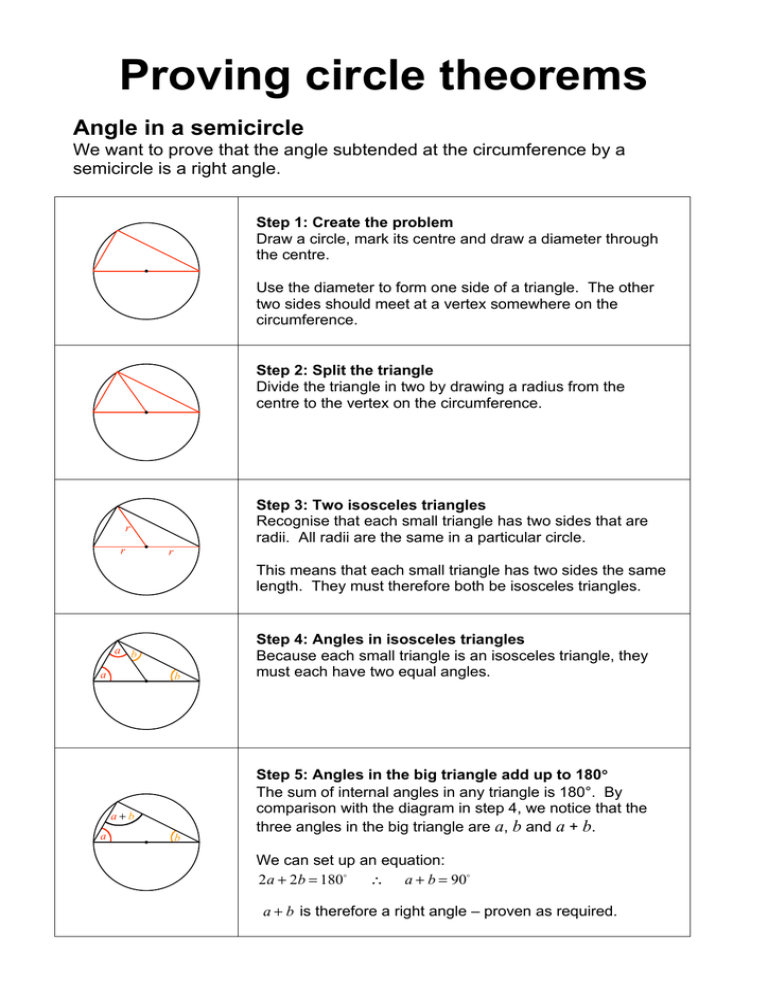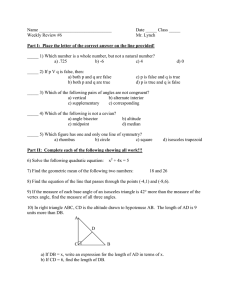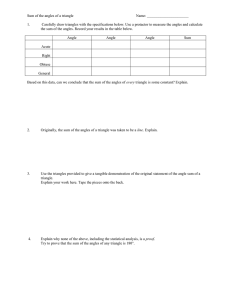Proving circle theorems - Benjamin
advertisement

Proving circle theorems Angle in a semicircle We want to prove that the angle subtended at the circumference by a semicircle is a right angle. Step 1: Create the problem Draw a circle, mark its centre and draw a diameter through the centre. Use the diameter to form one side of a triangle. The other two sides should meet at a vertex somewhere on the circumference. Step 2: Split the triangle Divide the triangle in two by drawing a radius from the centre to the vertex on the circumference. Step 3: Two isosceles triangles Recognise that each small triangle has two sides that are radii. All radii are the same in a particular circle. r r r This means that each small triangle has two sides the same length. They must therefore both be isosceles triangles. a b a b a+b a b Step 4: Angles in isosceles triangles Because each small triangle is an isosceles triangle, they must each have two equal angles. Step 5: Angles in the big triangle add up to 180° The sum of internal angles in any triangle is 180°. By comparison with the diagram in step 4, we notice that the three angles in the big triangle are a, b and a + b. We can set up an equation: 2a + 2b = 180! ! a + b = 90! a + b is therefore a right angle – proven as required. Angles at the centre and circumference We want to prove that the angle subtended by an arc at the centre of a circle is twice the angle subtended at any point on the circumference. Step 1: Create the problem Draw a circle and mark its centre. Choose two points on the circumference below the centre and one point on the circumference above the centre. b Draw a line connecting each point below the centre to the centre itself and to the point on the circumference above the centre. Label the angle at the centre (I’ve used a) and the angle at the circumference (I’ve used b). a In symbols, we want to prove that a = 2b. Step 2: Add a radius to from two isosceles triangles Draw a line from the centre to the point on the circumference above the centre. This is a radius, as are the other two lines from centre to circumference. Because all radii in the same circle are equal, two isosceles triangles have been formed – the fact that these triangles have two sides the same length is enough to make them isosceles. Step 3: Angles in isosceles triangles Because each small triangle is an isosceles triangle, they must each have two equal angles – the two angles not at the centre. w y x z y w b a The sum of angles inside any triangle is 180°. Therefore, 2w + x = 180° and 2y + z = 180°. Thus, x = 180° − 2w and z = 180° − 2y. Angles round a point add up to 180°, so a + x + z = 360°. Therefore (180° − 2w) + (180° − 2y) + a = 360°. Consequently 360°− 2w − 2y + a = 360°. So z − 2w − 2y = 0. As a result, a = 2w +2y, therefore a = 2(w +y). Using the fact that w + y = b, we conclude that a = 2b. Q.E.D. Angles in the same segment We want to prove that angles in the same segment are equal. a b Step 1: Create the problem Draw a circle, mark its centre and put a chord inside. The chord forms two segments. In one segment, draw two triangles that share the chord as one of their sides. Label the angles opposite the chord in each triangle. I’ve chosen the symbols a and b. Step 2: Draw in the angle at the centre Draw a third triangle – starting at the points where the chord touches the circumference, but with the other vertex at the centre of the circle. Label the angle at the centre – I used c. Based on the circle theorem that states the angle subtended by an arc at the centre of a circle is twice the angle subtended at any point on the circumference, angle c must be half the size of angle a. a a c b c c b But angle c must also be half the size of angle b. The only way both statements can be true is if angles a and b are equal. Opposite angles in a cyclic quadrilateral We want to prove the sum of opposite angles of a cyclic quadrilateral is 180°. Step 1: Create the problem Draw a circle and its centre, choose four points on its circumference and connect them with lines to form a cyclic quadrilateral. a b Label two opposite angles – I chose a and b. We want to prove that a + b = 180°. Step 2: Use another circle theorem! Draw two radii as shown. Since an angle subtended at the circumference by an arc is half that subtended at the centre, the angles round the centre are 2a and 2b. Angles round a point add up to 360° so 2a + 2b = 360°. a 2a 2b b Therefore a + b = 180°, so the theorem is proven. Alternate segment theorem All the alternate segment theorem really says is in the diagram to the right, the red angles are equal and the orange angles are equal. We want to prove the alternate angle theorem – that the angle between a tangent and a chord at the point of contact is equal to the angle in the alternate segment. Step 1: Create an alternate segment situation in a semicircle In order to prove the AST, construct a triangle in a A semicircle. Add tangent to the diameter forming the semicircle. I’ve labelled the points in my diagram to B " make it simpler to describe angles. O We want to prove that θ = ψ. In case you’re wondering, ψ is the Greek letter psi. It’s convenient to use Roman (normal) letters for points and Greek letters for angles. ! C Step 2: Spot the right angles Tangents always form right angles with diameters and radii. So the angles between OC and the tangent are 90°. One of those right angles can be split into angle θ and ∠BCA. Therefore ∠BCA + θ = 90°. The angle subtended at the circumference by a semicircle is always a right angle, so ∠ABC = 90°. Step 3: Putting the pieces of the puzzle together The interior angles in any triangle add up to 180°. Therefore ∠ABC + ∠BCA + ψ = 180°. We noted earlier that ∠ABC = 90°. Thus 90°+ ∠BCA + ψ = 180°. Simplifying the equation gives ∠BCA + ψ = 90°. We have established two facts: ∠BCA + ψ = 90° and ∠BCA + θ = 90°. You can state that in order for them to be true, θ = ψ. Or you rearrange a bit more to show the same thing: ∠BCA + ψ = 90° so ψ = 90° − ∠BCA ∠BCA + θ = 90° so θ = 90° − ∠BCA. 90° − ∠BCA can only have one value, so θ = ψ. Q.E.D.



